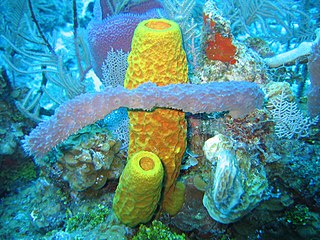
Demosponges (Demospongiae) are the most diverse class in the phylum Porifera. They include greater than 90% of all species of sponges with nearly 8,800 species worldwide. They are sponges with a soft body that covers a hard, often massive skeleton made of calcium carbonate, either aragonite or calcite. They are predominantly leuconoid in structure. Their "skeletons" are made of spicules consisting of fibers of the protein spongin, the mineral silica, or both. Where spicules of silica are present, they have a different shape from those in the otherwise similar glass sponges. Some species, in particular from the Antarctic, obtain the silica for spicule building from the ingestion of siliceous diatoms.
Dame Patricia Rose Bergquist was a New Zealand zoologist who specialised in anatomy and taxonomy. At the time of her death, she was professor emerita of zoology and honorary professor of anatomy with radiology at the University of Auckland.

Chromodoris quadricolor is a species of very colourful sea slug, a dorid nudibranch, a marine opisthobranch gastropod mollusc. The specific epithet quadricolor means four-coloured, so-named because this nudibranch is yellow, white, blue and black in color.
Acanthopolymastia is a small genus of demosponges belonging to the family Polymastiidae. It has three describe species. These small, bristly, cushion-shaped sponges are only known from deep-sea sites in the southern oceans.
Proteleia tapetum is a species of sea sponge belonging to the family Polymastiidae. It is found in shallow subtidal and intertidal habitats in the far north of North Island, New Zealand.
Polymastia lorum is a species of sea sponge belonging to the family Polymastiidae. It is only known from a single specimen found attached to a dead Glycimeris valve on a reef near Ohinau Island, one of the Mercury Islands off North Island, New Zealand.
Polymastia rubens is a species of sea sponge belonging to the family Polymastiidae. It is only known from rocky subtidal habitats around Kawau Island off North Island, New Zealand.
Polymastia aurantia is a species of sea sponge belonging to the family Polymastiidae. It is found in intertidal habitats including tide pools in the vicinity of Auckland, New Zealand.
Acanthopolymastia bathamae is a species of sea sponge belonging to the family Polymastiidae. It is only known from the Papanui Submarine Canyon off Dunedin, South Island, New Zealand.
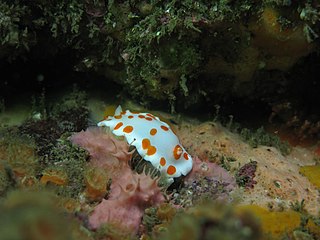
Goniobranchus tasmaniensis is a species of colourful sea slug, a dorid nudibranch, a marine gastropod mollusc in the family Chromodorididae.

Hypselodoris carnea is a species of colourful sea slug or dorid nudibranch, a marine gastropod mollusc in the family Chromodorididae.
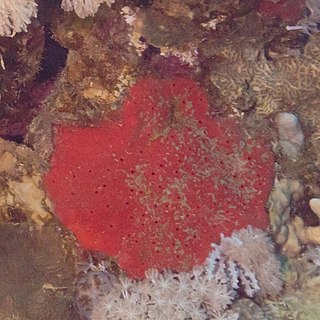
Dragmacidon lunaecharta, also known as the red ball sponge or red boring sponge, is a species of sea sponge found in the western Atlantic Ocean. It feeds on plankton. These sponges do not attach themselves to rocks or the sea floor but drift in water currents. Its main predators are seaslugs. It has been kept in home aquariums.
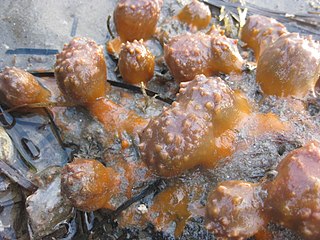
Aaptos is a genus of sea sponges in the family Suberitidae.

Callyspongia crassa, commonly known as prickly tube-sponge, is a species of sponge found from the Red Sea to the Seychelles. Its wide flexible brown tube with exterior protuberances can appear as a single tube or as clusters of tubes and can reach up to 50 centimeters in size. Like many other sea sponges, it is primarily used for marine drugs as they have many bioactive components and properties. They also play an important role in marine reef and benthic communities, as they constantly filter water and act as habitats for smaller organisms. As sea sponges, they have the ability to reproduce both sexually and asexually.
Dysidea arenaria is a species of marine sponge (poriferan) found in the Pacific Ocean. It is a member of the order Dictyoceratida, one of two sponge orders that make up the keratose or "horny" sponges in which a mineral skeleton is absent and a skeleton of organic fibers is present instead.

Thorectidae is a family of sea sponges in the order Dictyoceratida.
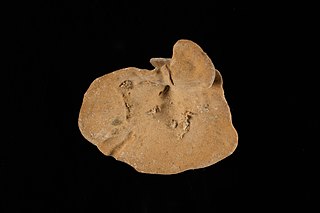
Cymbastela lamellata is a species of marine sponge in the family Axinellidae.
Phyllis Jane Fromont is a New Zealand and Australian scientist specialising in sponges.
Michelle Kelly, also known as Michelle Kelly-Borges, is a New Zealand scientist who specialises in sponges, their chemistry, their evolution, taxonomy, systematics, and ecology.

Hyrtios is a genus of sponges belonging to the family Thorectidae.










